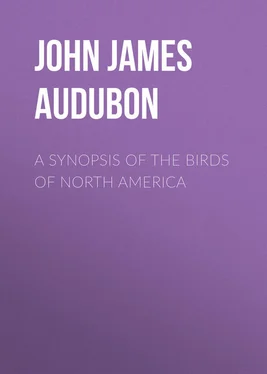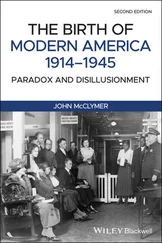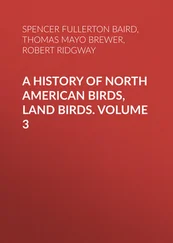John Audubon - A Synopsis of the Birds of North America
Здесь есть возможность читать онлайн «John Audubon - A Synopsis of the Birds of North America» — ознакомительный отрывок электронной книги совершенно бесплатно, а после прочтения отрывка купить полную версию. В некоторых случаях можно слушать аудио, скачать через торрент в формате fb2 и присутствует краткое содержание. Жанр: foreign_antique, foreign_prose, на английском языке. Описание произведения, (предисловие) а так же отзывы посетителей доступны на портале библиотеки ЛибКат.
- Название:A Synopsis of the Birds of North America
- Автор:
- Жанр:
- Год:неизвестен
- ISBN:нет данных
- Рейтинг книги:5 / 5. Голосов: 1
-
Избранное:Добавить в избранное
- Отзывы:
-
Ваша оценка:
- 100
- 1
- 2
- 3
- 4
- 5
A Synopsis of the Birds of North America: краткое содержание, описание и аннотация
Предлагаем к чтению аннотацию, описание, краткое содержание или предисловие (зависит от того, что написал сам автор книги «A Synopsis of the Birds of North America»). Если вы не нашли необходимую информацию о книге — напишите в комментариях, мы постараемся отыскать её.
A Synopsis of the Birds of North America — читать онлайн ознакомительный отрывок
Ниже представлен текст книги, разбитый по страницам. Система сохранения места последней прочитанной страницы, позволяет с удобством читать онлайн бесплатно книгу «A Synopsis of the Birds of North America», без необходимости каждый раз заново искать на чём Вы остановились. Поставьте закладку, и сможете в любой момент перейти на страницу, на которой закончили чтение.
Интервал:
Закладка:
Plate CCCLIX. Fig. 3. Male.
Tail longer than the body; upper part of the head, cheeks, and hind neck ash-grey; back brownish-grey, rump dusky; anterior wing-coverts scarlet, quills brownish-black, tail-feathers deep black, the three outer on each side rose-coloured to near the end; lower parts white before, rose-coloured behind.
Male , 11, wing 51/8.
Arkansas. Rare in Louisiana.
Swallow-tailed Flycatcher, Muscicapa forficata, Bonap. Amer. Orn. v. i. p. 15.
Muscicapa forficata, Bonap. Syn. p. 275.
Swallow-tailed Flycatcher, Muscicapa forficata, Nutt. Man. v. i. p. 275.
Swallow-tailed Flycatcher, Muscicapa forficata, Aud. Orn. Biog. v. iv. p. 426.
GENUS II. MUSCICAPA, Linnæus. FLYCATCHER
Bill moderate, or rather long, stout, straight, broad at the base, gradually compressed toward the end; upper mandible with the dorsal outline sloping, the edges sharp and overlapping, with a very small notch close to the small deflected tip; lower mandible with the ridge very broad at the base, the sides rounded, the tip minute and ascending. Nostrils basal, roundish. Head rather large, depressed; neck short; body rather slender. Feet short; tarsus very short, slender, with six very broad scutella, three of which almost meet behind; toes free, the hind toe large, all scutellate above; claws rather long, very slender, arched, finely pointed. Plumage soft and blended. Wings long, second and third quills longest; outer primaries generally attenuated at the end. Tail long, even, or emarginate.
* Bill large. Head with a vermilion patch, outer quills attenuated. Tyrannus of authors.
54. 1. Muscicapa verticalis, Say. Arkansaw Flycatcher
Plate CCCLIX. Fig. 1. Male. Fig. 2. Female.
The outer five primaries much attenuated toward the end, the first more so, the fifth least, the third longest, but the outer four nearly equal; tail almost even. Upper parts ash-grey, the back tinged with yellow; a patch of bright vermilion on the top of the head; wing-coverts and quills chocolate-brown; upper tail-coverts and tail black, the outer web of the lateral feathers yellowish-white; throat greyish-white, sides and fore part of neck ash-grey, the rest of the lower parts pure yellow. Female similar.
Male , 9, 151/2.
Columbia River, Rocky Mountains, and across to Texas. Accidental in Louisiana. Migratory.
Tyrannus verticalis, Say Long's Exped. v. ii. p. 60.
Arkansaw Flycatcher, Muscicapa verticalis, Bonap. Amer. Orn. v. i. p. 18.
Muscicapa verticalis, Bonap. Syn. p. 67.
Arkansaw Flycatcher, Muscicapa verticalis, Nutt. Man. v. i. p. 273.
Arkansaw Flycatcher, Muscicapa verticalis, Aud. Orn. Biog. v. iv. p. 422; v. v.
55. 2. Muscicapa dominicensis, Brisson. Pipiry Flycatcher
Plate CLXXII. Male.
The outer six primaries attenuated at the end, the first more so, the sixth least; the third longest, but the second almost equal, the fourth and fifth very little shorter, the first much longer than the seventh; tail emarginate. Upper parts dull ash-grey, shaded with brown posteriorly; a concealed patch of bright vermilion on the top of the head; wing-coverts, quills and tail chocolate-brown, margined with brownish-white; lower parts anteriorly ash-grey, behind greyish-white tinged with yellow, lower wing-coverts pale sulphur yellow. Female similar.
Male , 87/8, 143/8.
Florida Keys; and southern parts of South Carolina. Abundant. Migratory.
Tyrannus griseus, Vieill., Ois. d'Amer. pl. 46.
Pipiry Flycatcher, Muscicapa dominicensis, Aud. Orn. Biog. v. ii. p. 392.
56. 3. Muscicapa Tyrannus, Linn. Tyrant Flycatcher, – King Bird
Plate LXXIX. Male and Female.
The outer two primaries attenuated at the end, the second longest, the first longer than the third; tail even. Upper parts dark bluish-grey, the head greyish-black, with a bright vermilion patch margined with yellow; quills, coverts, and tail-feathers brownish-black, the former margined with dull white; the latter largely tipped with white; lower parts greyish-white, the breast pale grey. Female duller, the upper parts tinged with brown, the lower more dusky.
Male , 81/2, 141/2.
North America generally. Migratory. A few winter in South Florida.
Lanius Tyrannus, Linn. Syst. Nat. v. i. p. 136.
Tyrant Flycatcher, Muscicapa Tyrannus, Wils. Amer. Orn. v. i. p. 66.
Muscicapa Tyrannus, Bonap. Syn. p. 66.
King-bird or Tyrant Flycatcher, Muscicapa Tyrannus, Nutt. Man. v. i. p. 265.
Tyrant Flycatcher, Muscicapa Tyrannus, Aud. Orn. Biog. v. i. p. 403; v. v. p. 420.
** Bill large. Head plain, crested, quills not attenuated.
57. 4. Muscicapa crinita, Linn. Great Crested Flycatcher
Plate CXXIX. Male.
Third quill longest, first and sixth equal; upper parts dull greenish-olive; quills and coverts dark brown, the primaries margined with light red, the secondaries with yellowish-white, of which there are two bars across the wing, formed by the tips of the secondary coverts and first row of small coverts; inner webs of the tail-feathers, except the two middle, light red; margins of inner webs of quills tinged with the same; fore-neck and sides of the head greyish-blue, the rest of the lower parts yellow. Female similar.
Male , 81/2, 13.
From Texas northward, generally distributed. Abundant. Migratory.
Great Crested Flycatcher, Muscicapa crinita, Wils. Amer. Orn. v. ii. p. 75.
Muscicapa crinita, Bonap. Syn. p. 67.
Great Crested Flycatcher, Nutt. Man. v. i. p. 271.
Great Crested Flycatcher, Muscicapa crinita, Aud. Orn. Biog. v. ii. p. 176; v. v. p. 423.
58. 5. Muscicapa Cooperi, Nuttall. Cooper's Flycatcher. – Olive-sided Flycatcher
Wing pointed, second quill longest, first longer than third, tail emarginate, the three first primaries very slightly attenuated at the ends; upper parts, cheeks, and sides of the neck, dusky brown, tinged with greyish-olive, the head darker; quills and tail blackish-brown, the secondaries margined with brownish-white; downy feathers on the sides of the rump white; lower parts greyish-white, the sides dusky grey. Young similar to adult.
Male , 71/2, 123/4.
From Texas northward along the Atlantic. Never seen far in the interior. Columbia River. Migratory.
Olive-sided Flycatcher or Pe-pe, Muscicapa Cooperi, Nutt. Man. v. i. p. 282.
Tyrannus borealis, Northern Tyrant, Swains. & Rich. F. Bor. Amer. v. ii. p. 141.
Olive-sided Flycatcher, Muscicapa Cooperi, Aud. Orn. Biog. v. ii. p. 422; v. v. p. 422.
* Bill more slender. Tyrannula of authors.
59. 6. Muscicapa Saya, Bonap. Say's Flycatcher
Plate CCCLIX. Fig. 4. Male. Fig. 5. Female.
Third quill longest, second and fourth scarcely shorter, first a little longer than sixth; tail very slightly emarginate; upper parts greyish-brown; upper tail-coverts and tail brownish-black; wings of a darker tint than the back, the feathers margined with brownish-white; a dusky spot before the eye; fore part and sides of neck light greyish-brown, shaded with pale brownish-red on the breast and abdomen; lower wing-coverts reddish-white.
Male , 7, wing 42/12.
Arkansas. Columbia River. Fur Countries. Never seen along the Atlantic. Abundant. Migratory.
Say's Flycatcher, Muscicapa Saya, Bonap. Amer. Orn. v. i. p. 20.
Muscicapa Saya, Bonap. Syn. p. 67.
Tyrannula Saya, Swains. & Rich. F. Bor. Amer. v. ii. p. 142.
Say's Flycatcher, Muscicapa Saya, Nutt. Man. v. i. p. 277.
Say's Flycatcher, Muscicapa Saya, Aud. Orn. Biog. v. iv. p. 428.
60. 7. Muscicapa nigricans, Swains. Rocky Mountain Flycatcher
Интервал:
Закладка:
Похожие книги на «A Synopsis of the Birds of North America»
Представляем Вашему вниманию похожие книги на «A Synopsis of the Birds of North America» списком для выбора. Мы отобрали схожую по названию и смыслу литературу в надежде предоставить читателям больше вариантов отыскать новые, интересные, ещё непрочитанные произведения.
Обсуждение, отзывы о книге «A Synopsis of the Birds of North America» и просто собственные мнения читателей. Оставьте ваши комментарии, напишите, что Вы думаете о произведении, его смысле или главных героях. Укажите что конкретно понравилось, а что нет, и почему Вы так считаете.












